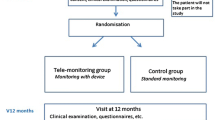Abstract
Introduction
In this paper, we evaluated the feasibility of a telemedical (TM) support program and its effect on glycemic control in adolescents with type 1 diabetes mellitus (T1DM). Thirty-six adolescents (m=20, median age at the start of the study: 15.3 years (range: 10.7–19.3 years), median age at diagnosis: 9.3 years (2.1–13.8 years), median duration of disease: 6.4 years (1.0–12.8 years), HbA1c>8%, all on intensified insulin therapy) were randomized in a crossover trial over 6 months (3 months with TM, 3 months with conventional support and paper diary (PD)). During the TM phase, the patients sent their data (date, time, blood glucose, carbohydrate intake, insulin dosage) via mobile phone, at least daily, to our server and diabetologists sent back their advice via short message service (SMS) once a week.
Results
Glycemic control improved during the TM phase, while it deteriorated during the PD phase: TM-PD group HbA1c (%, median (range)): 9.05 (8–11.3) (at 0 months), 8.9 (6.9–11.3) (at 3 months), and 9.2 (7.4–12.6) (at 6 months), and PD-TM group: 8.9 (8.3–11.6), 9.9 (8.1–11), and 8.85 (7.3–11.7) (p<0.05). Patients rated the TM support program to be a good idea. Technical problems with General Packet Radio Service (GPRS) data transmission led to data loss and decreased patient satisfaction.
Conclusion
Our telemedical support program, VIE-DIAB, proved to be feasible in adolescents and helped to improve glycemic control.



Similar content being viewed by others
Abbreviations
- T1DM:
-
Type 1 diabetes mellitus
- TM:
-
Telemedicine/telemedical
- PD:
-
Paper diary
- BMI:
-
Body mass index
- DCCT:
-
The Diabetes Control and Complications Trial
- SMS:
-
Short message service
- GPRS:
-
General Packet Radio Service
References
American Diabetes Association (1999) Clinical practice recommendations. Diabetes Care 22(Suppl 1):S35
Bellazzi R, Montani S, Riva A, Stefanelli M (2001) Web-based telemedicine systems for home-care: technical issues and experiences. Comput Methods Prog Biomed 64(3):175–187
Biermann E, Dietrich W, Rihl J, Standl E (2002) Are there time and cost savings by using telemanagement for patients on intensified insulin therapy? A randomised, controlled trial. Comput Methods Programs Biomed 69(2):137–146
Chase HP, Pearson JA, Wightman C, Roberts MD, Oderberg AD, Garg SK (2003) Modem transmission of glucose values reduces the costs and need for clinic visits. Diabetes Care 26(5):1475–1479
d’Annunzio G, Belazzi R, Larizza C, Montani S, Pennati C, Castelnovi C, Stefanelli M, Rondini G, Lorini R (2003) Telemedicine in the management of young patients with type 1 diabetes mellitus: a follow-up study. Acta Biomed Ateneo Parmese 74(Suppl 1):49–55
The DCCT Research Group (1987) Diabetes control and complications trial (DCCT): results of feasibility study. Diabetes Care 10(1):1–19
The DCCT Research Group (1993) The effect of intensive treatment of diabetes on the development and progression of long-term complications in insulin-dependent diabetes mellitus. N Engl J Med :329(14):977–986
The DCCT Research Group (1994) Effect of intensive diabetes treatment on the development and progression of long-term complications in adolescents with insulin-dependent diabetes mellitus. J Pediatr 125(2):177–188
Holl RW, Swift PG, Mortensen HB, Lynggaard H, Hougaard P, Aanstoot HJ, Chiarelli F, Daneman D, Danne T, Dorchy H, Garandeau P, Greene S, Hoey HM, Kaprio EA, Kocova M, Martul P, Matsuura N, Robertson KJ, Schoenle EJ, Sovik O, Tsou RM, Vanelli M, Aman J (2003) Insulin injection regimens and metabolic control in an international survey of adolescents with type 1 diabetes over 3 years: results from the Hvidore study group. Eur J Pediatr 162(1):22–29
Howells L, Wilson AC, Skinner TC, Newton R, Morris AD, Greene SA (2002) A randomized control trial of the effect of negotiated telephone support on glycaemic control in young people with Type 1 diabetes. Diabet Med 19(8):643–648
Montori VM, Smith SA (2001) Information systems in diabetes: in search of the holy grail in the era of evidence-based diabetes care. Exp Clin Endocrinol Diabetes 109(Suppl 2):S358–S372
Perlemuter L, Yomtov B (2002) Feasibility and usefulness of dedicated software and e-mail for self-monitoring blood glucose in treating diabetes. Diabet Med 19(8):701–702
SAS Institute (1999) SAS/STAT user’s guide, version 8. SAS Institute Inc., Cary, North Carolina
Stone AA, Shiffman S, Schwartz JE, Broderick JE, Hufford MR (2002) Patient non-compliance with paper diaries. BMJ 324(7347):1193–1194
Acknowledgment
This project was, in part, sponsored by Telecom Austria.
Author information
Authors and Affiliations
Corresponding author
Rights and permissions
About this article
Cite this article
Rami, B., Popow, C., Horn, W. et al. Telemedical support to improve glycemic control in adolescents with type 1 diabetes mellitus. Eur J Pediatr 165, 701–705 (2006). https://doi.org/10.1007/s00431-006-0156-6
Received:
Accepted:
Published:
Issue Date:
DOI: https://doi.org/10.1007/s00431-006-0156-6




